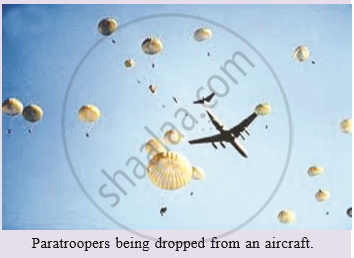Advertisements
Advertisements
Question
A stream of water flowing horizontally with a speed of 15 m s–1 gushes out of a tube of cross-sectional area 10–2 m2, and hits a vertical wall nearby. What is the force exerted on the wall by the impact of water, assuming it does not rebound?
Solution 1
Speed of the water stream, v = 15 m/s
Cross-sectional area of the tube, A = 10–2 m2
Volume of water coming out from the pipe per second,
V = Av = 15 × 10–2 m3/s
Density of water, ρ = 103 kg/m3
Mass of water flowing out through the pipe per second = ρ × V = 150 kg/s
The water strikes the wall and does not rebound. Therefore, the force exerted by the water on the wall is given by Newton’s second law of motion as:
F = Rate of change of momentum = `(triangleP)/(trianglet)`
`= "mv"/t`
= 150 x 15 = 2250 N
Solution 2
In one second, the distance travelled is equal to the velocity v.
Volume of water hitting the wall per second, V = av where a is the cross-sectional area of the tube and v is the speed of water coming out of the tube.
V = 10-2 m2 x 15 ms-1 = 15 x 10-2 m3 s-1
Mass of water hitting the wall per second = 15 x 10-2 x 103 kg s-1 = 150 kg s-1 [v density of water = 1000 kg m-3] Initial momentum of water hitting the wall per second
= 150 kg s-1 x 15 ms-1 = 2250 kg ms-2 or 2250 N Final momentum per second = 0
Force exerted by the wall = 0 – 2250 N = – 2250 N Force exerted on the wall = – (- 2250) N = 2250 N.
APPEARS IN
RELATED QUESTIONS
From a rifle of mass 4 kg, a bullet of mass 50 g is fired with an initial velocity of 35 m s−1. Calculate the initial recoil velocity of the rifle.
Figure shows the position-time graph of a body of mass 0.04 kg. Suggest a suitable physical context for this motion. What is the time between two consecutive impulses received by the body ? What is the magnitude of each impulse ?

Name the physical quantity which is considered to be a measure of the quantity of motion of a body.
A plastic ball and a clay ball of equal masses, travelling in the same direction with equal speeds, strike against a vertical wall. From which ball does the wall receive a greater amount of momentum ?
Which physical principle is involved in the working of a jet aeroplane ?
A 10 g bullet travelling at 200 m/s strikes and remains embedded in a 2 kg target which is originally at rest but free to move. At what speed does the target move off ?
A 150 g ball, travelling at 30 m/s, strikes the palm of a player’s hand and is stopped in 0.05 second. Find the force exerted by the ball on the hand.
The troops (soldiers) equipped to be dropped by parachutes from an aircraft are called paratroopers. Why do paratroopers roll on landing ?
Two billiard balls A and B, each of mass 50 g and moving in opposite directions with speed of 5 ms–1 each, collide and rebound with the same speed. If the collision lasts for 10–3 s, which of the following statements are true?
- The impulse imparted to each ball is 0.25 kg ms–1 and the force on each ball is 250 N.
- The impulse imparted to each ball is 0.25 kg ms–1 and the force exerted on each ball is 25 × 10–5 N.
- The impulse imparted to each ball is 0.5 Ns.
- The impulse and the force on each ball are equal in magnitude and opposite in direction.
A girl riding a bicycle along a straight road with a speed of 5 ms–1 throws a stone of mass 0.5 kg which has a speed of 15 ms–1 with respect to the ground along her direction of motion. The mass of the girl and bicycle is 50 kg. Does the speed of the bicycle change after the stone is thrown? What is the change in speed, if so?
